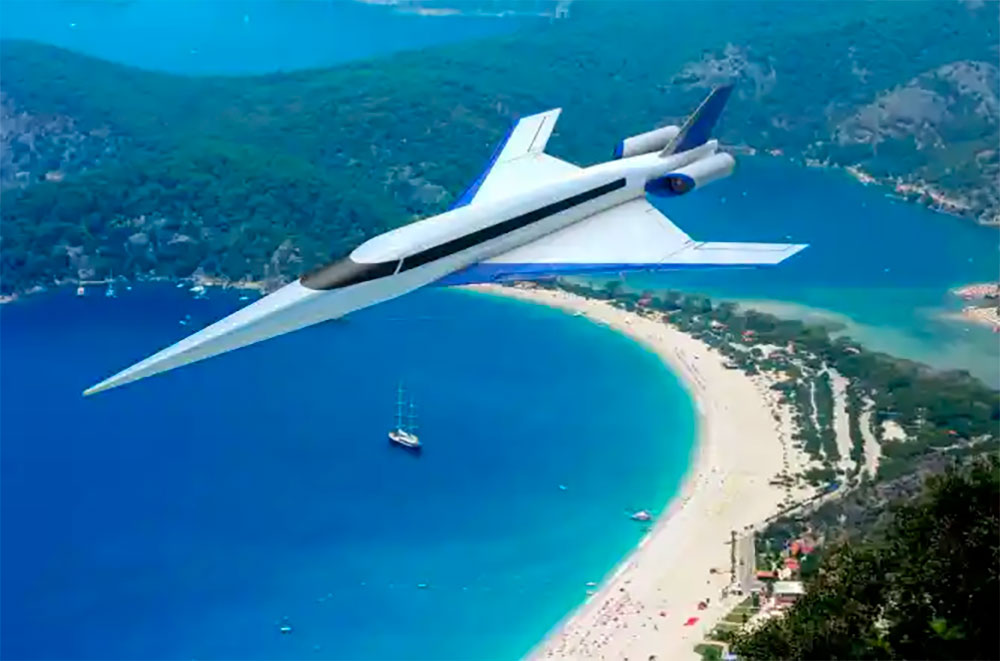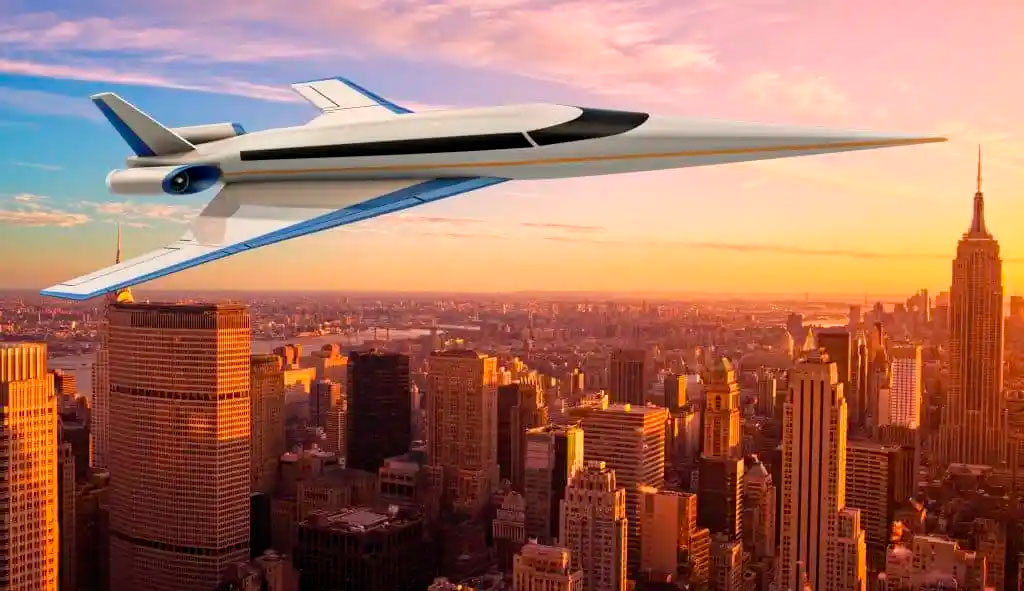The Spike S-512 QSJ is a supersonic business jet designed to cruise at Mach 1.6 with a range of 6,200 miles, featuring Quiet Supersonic Flight technology.
The Spike S-512 Quiet Supersonic Jet (QSJ) is an advanced supersonic business aircraft engineered to significantly reduce travel times for intercontinental journeys. Designed to cruise at speeds up to Mach 1.6 (1,100 mph or 1,770 km/h), it aims to halve flight durations compared to conventional subsonic jets. The aircraft features a range of 6,200 nautical miles (11,482 kilometers), enabling non-stop flights on routes such as New York to London in approximately three hours. A notable design element is its windowless fuselage, which incorporates high-definition screens displaying real-time external views, enhancing structural integrity and passenger experience. The S-512 employs proprietary Quiet Supersonic Flight (QSF) technology to minimize sonic boom effects, allowing supersonic travel over land without causing ground-level disturbances. With a seating capacity of up to 18 passengers, the Spike S-512 QSJ represents a significant advancement in supersonic aviation, combining speed, efficiency, and comfort.
History of the Development of the Spike S-512 QSJ
The concept of supersonic passenger travel has intrigued the aviation industry since the mid-20th century, culminating in the introduction of the Concorde in the 1970s. Despite its technological achievements, the Concorde faced challenges such as high operational costs, environmental concerns, and disruptive sonic booms, leading to its retirement in 2003. The subsequent absence of supersonic commercial flights created a market gap for faster air travel.
In response to this opportunity, Spike Aerospace was founded in Boston, Massachusetts, with the vision of developing a supersonic business jet that overcomes the drawbacks of its predecessors. The company officially announced the Spike S-512 project in 2013, aiming to create an aircraft capable of supersonic speeds while minimizing environmental impact and enhancing passenger experience.
The initial design phase focused on addressing the sonic boom issue that had plagued earlier supersonic aircraft. Spike Aerospace’s engineering team, comprising experts from leading aerospace companies, dedicated significant efforts to developing Quiet Supersonic Flight (QSF) technology. This proprietary innovation aims to reduce the sonic boom to less than 75 perceived loudness decibels (PLdB), approximately equivalent to the sound of a soft clap at ground level. This advancement is intended to enable the S-512 QSJ to operate at supersonic speeds over land without causing significant noise disturbances.
In parallel with noise reduction efforts, the design team explored various aerodynamic configurations to enhance performance and efficiency. By 2015, the S-512’s design had evolved to feature a modified delta wing and a sleek, windowless fuselage. The absence of windows not only improves structural integrity but also reduces weight and drag. Instead, the interior walls are lined with high-definition screens projecting real-time external views captured by micro-cameras mounted on the aircraft’s exterior. This innovative approach enhances passenger comfort and safety.
Throughout the development process, Spike Aerospace has engaged in collaborations with various aerospace partners and suppliers to integrate advanced materials, propulsion systems, and avionics into the S-512 QSJ. The company has also conducted extensive computational simulations and wind tunnel testing to validate the aircraft’s performance characteristics.
As of 2025, the Spike S-512 QSJ is in the advanced stages of development, with plans for prototype testing and certification underway. Spike Aerospace aims to bring the S-512 QSJ to market in the near future, offering a viable solution for supersonic business travel that combines speed, efficiency, and environmental responsibility.

Design of the Spike S-512 QSJ
The design of the Spike S-512 Quiet Supersonic Jet (QSJ) integrates advanced aerodynamics, innovative materials, and cutting-edge technology to achieve high-speed performance while ensuring passenger comfort and environmental compliance.
Fuselage and Aerodynamics
The S-512 features a streamlined fuselage measuring approximately 131 feet (40 meters) in length, designed to minimize aerodynamic drag and optimize supersonic cruise efficiency. The aircraft’s wingspan is 60 feet (18.3 meters), with a wing area of 1,125 square feet (104.5 square meters). The modified delta wing configuration, characterized by a highly swept leading edge, reduces wave drag and enhances aerodynamic efficiency at both low and high speeds. This wing design also contributes to improved stability and control during various flight phases.
Windowless Cabin and Multiplex Digital Display
A distinctive feature of the S-512 is its windowless passenger cabin. Traditional windows are replaced with thin, high-definition video screens embedded along the interior walls. These screens display panoramic external views captured by an array of micro-cameras mounted on the aircraft’s exterior, providing passengers with real-time visuals of their surroundings. This design choice enhances structural integrity by eliminating window cutouts, reduces the aircraft’s weight, and allows for a smoother external surface, thereby decreasing drag. Passengers have the option to customize their viewing experience, selecting from live external feeds, pre-recorded scenic imagery, or other multimedia content.
Quiet Supersonic Flight Technology
The S-512 incorporates proprietary Quiet Supersonic Flight (QSF) technology to reduce the impact of the sonic boom. Traditional supersonic aircraft produce shockwaves that create a loud noise upon breaking the sound barrier. The QSF system manipulates the airflow around the aircraft to soften the pressure waves, significantly reducing the perceived noise on the ground. Estimates suggest that the S-512’s sonic boom will be below 75 PLdB, similar to the sound of a car door closing, allowing it to fly over populated areas without regulatory restrictions.
Materials and Structural Components
The airframe is constructed using lightweight composite materials, including carbon fiber-reinforced polymers and titanium alloys. These materials provide high strength-to-weight ratios, corrosion resistance, and thermal stability at high speeds. The aircraft also integrates advanced heat-resistant coatings to withstand the aerodynamic heating associated with sustained supersonic flight.
Performance of the Spike S-512 QSJ
The Spike S-512 is designed for high-speed, long-range travel, significantly reducing flight times on intercontinental routes.
Speed and Altitude
The S-512 has a maximum cruise speed of Mach 1.6 (1,100 mph or 1,770 km/h), which is 60% faster than conventional subsonic business jets. Its operational altitude is 51,000 feet (15,545 meters), allowing it to fly above commercial air traffic, reducing turbulence and optimizing fuel efficiency.
Range and Fuel Efficiency
The aircraft has a range of 6,200 nautical miles (11,482 kilometers), enabling non-stop travel between major global cities such as Los Angeles to Tokyo or New York to London in approximately three hours. The fuel consumption is optimized using next-generation turbofan engines, which incorporate variable cycle technology to improve efficiency across different flight regimes.
Engines and Power
The S-512 is powered by two Rolls-Royce or GE Aviation high-bypass turbofan engines, specifically designed for supersonic operation. These engines provide approximately 20,000 lbf (89 kN) of thrust each, allowing the aircraft to achieve rapid acceleration and sustained supersonic cruise. The engine nacelles are aerodynamically shaped to minimize drag and enhance noise reduction capabilities.
Comparison to Competitors
The S-512 is positioned against potential supersonic business jet competitors such as the Aerion AS2 and Boom Overture. While the Aerion AS2 is projected to cruise at Mach 1.4, the S-512’s Mach 1.6 capability provides a clear speed advantage. Compared to Boom Overture, which focuses on commercial supersonic travel, the S-512 is tailored for private business aviation, offering a more exclusive and customizable experience.

Variants of the Spike S-512 QSJ
Spike Aerospace has proposed different configurations for the S-512, catering to various market demands.
- Standard S-512 QSJ – The baseline variant with a seating capacity of 12-18 passengers, optimized for business and luxury travel. It features the full Quiet Supersonic Flight technology and digital cabin displays.
- Extended Range S-512 – A proposed variant with additional fuel capacity, extending the range beyond 7,000 nautical miles (12,964 km) for ultra-long-haul operations.
- Military & Government S-512 – A conceptual variant tailored for government and defense applications. This version would incorporate secure communication suites, enhanced countermeasure systems, and potential modifications for reconnaissance missions.
Military Missions of the Spike S-512 QSJ
While primarily designed as a business jet, the S-512 has potential military applications. Governments and defense agencies could utilize the aircraft for various missions, leveraging its speed and altitude advantages.
Reconnaissance and Surveillance
The S-512 could be modified for high-speed surveillance and reconnaissance. With its 51,000 feet altitude ceiling, it can operate beyond the reach of most ground-based defenses. A military version may integrate electro-optical/infrared (EO/IR) sensors, synthetic aperture radar (SAR), and secure communications systems for intelligence-gathering missions.
High-Speed Executive Transport
Military and government officials requiring rapid, secure transportation could use a customized S-512 variant. The aircraft’s stealthy supersonic operation would allow leaders to travel across continents in a fraction of conventional flight times, reducing logistical delays during critical missions.
Potential Armament
Although the S-512 is not designed for combat, a military adaptation could include self-defense countermeasures such as infrared (IR) flares, radar jamming pods, and electronic warfare suites to enhance survivability in hostile airspace.
Competing Aircraft
Potential competitors in the military space include the Gulfstream C-37B (based on the Gulfstream G550), which serves as an executive transport aircraft but lacks supersonic capability. The Lockheed Martin SR-72, a hypersonic reconnaissance concept, could also influence military supersonic jet developments.
Current Status and Future Prospects
As of 2025, the S-512 is in the advanced development phase, with Spike Aerospace seeking partnerships for full-scale production. The company has secured preliminary interest from business aviation operators and government agencies.
The Spike S-512 QSJ represents a significant step forward in supersonic aviation, offering Mach 1.6 cruise speeds, a 6,200 nautical mile range, and advanced Quiet Supersonic Flight technology. Its windowless fuselage with digital cabin displays enhances structural integrity and passenger experience, while its high-altitude performance minimizes turbulence and optimizes fuel efficiency. The S-512’s potential military applications further expand its versatility. If successful, it could mark the return of commercial supersonic flight in a more sustainable and efficient manner, reshaping the future of high-speed travel.
Back to the experimental aircraft section.